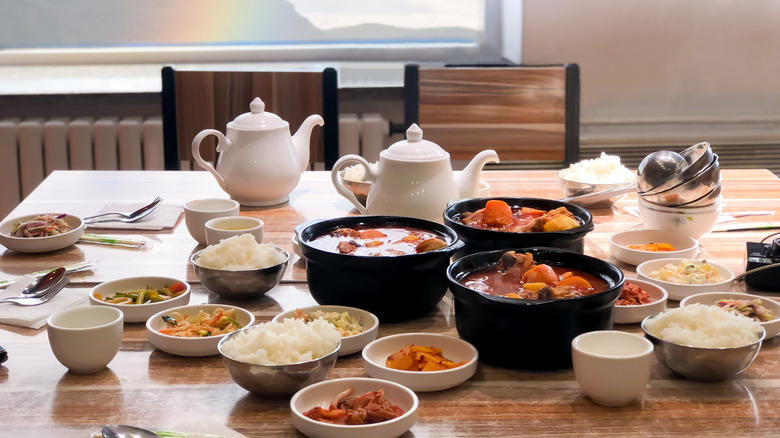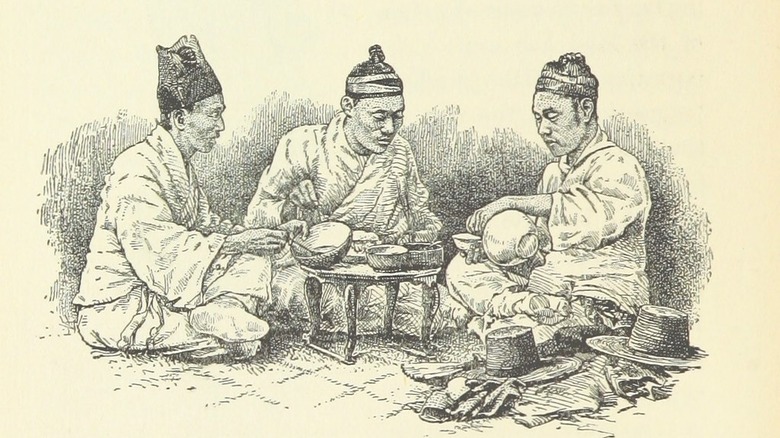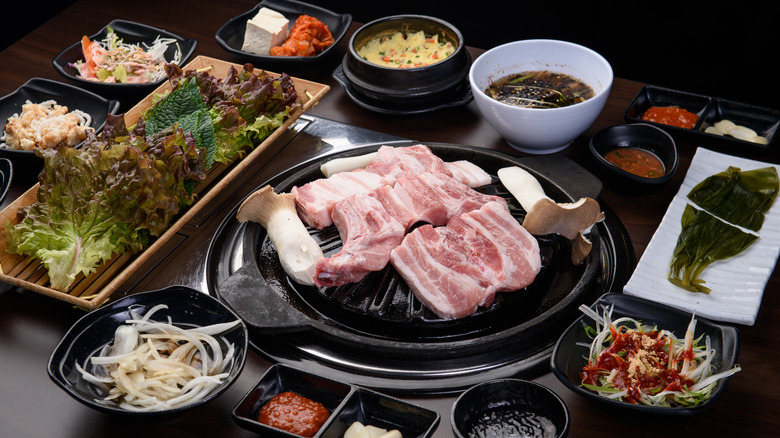A Brief History Of Korea's Ancient Feasts
If you've ever eaten at a restaurant specializing in Korean barbecue, then you know that in addition to the meats, seafood, vegetables, and other items you can order for cooking over your in-table grill, you are going to receive a panoply of visually stunning, strongly-flavored items in small dishes. Banchan can seem, especially to those used to western dining norms, like appetizers, and treating them as such is perfectly acceptable. But, in reality, they are meant more as accompaniments and flavor modifiers to be used with what you're putting on the grill.
Because of the banchan, a menagerie of meats brought to the table, and the convivial atmosphere of Korean barbecue, some might get the impression that Korean culture places value in feasts. Turns out, this isn't far from the truth. As Atlas Obscura points out, the Korean peninsula — now divided between the nations of the northern DPRK and South Korea — has long been a land of plenty. With a bounty at hand, dining norms among Koreans came to favor meals of auspicious quantity.
Feeding a nation
Atlas Obscura lists many historical accounts that give credence to the hearty nature of Korean consumption. These include records of Korean spies who misread an invading army's supplies during a siege, the daily eating and drinking habits of an ancient king and his favorites, and the complaints of a scholar who told the king his subjects ate in a meal what their Chinese neighbors eat in a day.
Further visual evidence, such as an illustration from an 1897 book about Korea and a photographic postcard of a man dining alone that was sold in France, bears the point home. In the postcard, the man, seemingly slender, is looking up from a tray holding a terrine of soup, a mammoth bowl of rice, and various smaller bowls and plates of food. The photograph is telling, as rice was often reported as the workhorse of Korean sustenance. Also beloved were peaches, Korean melons, red peppers, and rice wine.
One possible reason for the sheer volume of food consumed by Koreans before the turn of the twentieth century was that many toiled in labor and on farms, says Atlas Obscura. As life there — and in much of the world — became more sedentary, portions dwindled. Another theory, posited by Asia Society, is that a large number of dishes on a table — as opposed to other cultures that served dishes sequentially — was visually pleasing.
Korean-style feasting today
Though times have changed and most Koreans don't consume liters of rice at every meal, it is still quite accessible to feast on Korean cuisine, both on the peninsula and abroad. Korean barbecue, explains Next Shark, dates back over 2,000 years to maekjeok, which were skewers cooked over an open fire, a favorite of nomadic tribes that traversed what is now Korea. Food and dishes naturally evolve, and maekjeok, along with charbroiled beef slices known as neobiani, is what we now know as bulgogi. Literally translated as "fire meat," bulgogi features thin slices of beef bathed in soy sauce, sesame oil, and sugar. This marinade caramelizes over the flame and adds a sweet, umami-laden crust to the meat within.
But bulgogi alone doesn't make a feast, and that is most decidedly what Korean barbecue is — a celebration of flavors, scents, and plenty to be enjoyed with family and friends. In addition, one may choose to grill up beef short ribs, known as kalbi, in a similarly flavorful marinade. As explained in our article on DIY Korean barbecue, fatty pork belly and lean skirt and flank steaks are usual suspects, in addition to sturdy vegetables, like white onion and trumpet mushrooms. If you're lucky enough to live near an H Mart — a Korean grocery chain — then most of these items will be readily available, though other Asian grocery stores and even a few U.S. chains might have what you need.


